Work Envelope Expansion and Parametric Optimization in WAAM with Relative Density and Surface Aspect as Quality Constraints: The Case of Al5Mg Thin Walls with Active Cooling
Abstract
:1. Introduction
2. Methodology
- (a)
- Establishment of an operational map (hardware capabilities/limitations);
- (b)
- Design of a work envelope: A region within the operational map that meets some acceptance criteria;
- (c)
- Expansion of the work envelope through an upgrade of the welding hardware to WAAM purposes and improvement of process robustness;
- (d)
- Application of multi-objective numerical optimization based on the work envelope data;
- (e)
- Ordering of a decision-making procedure towards achieving intended preform quality features.
2.1. Experimental Procedures
2.2. Measurements
- Arc energy: Arc energy per unit length of deposit (J/mm);
- Pinst: Average instantaneous arc power (W);
- TS: Travel speed (mm/s);
- U: Deposition voltage (V);
- I: Deposition current (A).
2.3. Operational Map and Work Envelope
2.3.1. Definition of the Operational Map Boundaries: Hardware Capabilities
2.3.2. Starting Point for the Development of the Work Envelope
- TWW: Total wall width (mm);
- WFS: Wire feed speed (mm/s);
- TS: Travel speed (mm/s);
- WFS/TS: Wire deposition per unit length of deposit (-);
- Wirearea: Wire cross-section area (mm2).
2.3.3. The Work Envelope: Matrix of Experiments
2.3.4. The Work Envelope: Acceptance Criteria
3. Results
3.1. Deposition Parameters Analyses
3.2. Work Envelope
- Due to a higher WFS/TS, i.e., a higher wire deposition per unit length of deposit, the liquid volume of the molten pool interposed between the arc root and the previous layer is large, so that the heat input coming from the arc needs to pass through this liquid barrier first before reaching the solid previous layer and melt it more effectively; or
- Due to a lower WFS/TS, i.e., a lower arc energy per unit length of deposit, there is insufficient remelting of the previous layer.
3.2.1. Work Envelope Expansion
3.2.2. Expanded Work Envelope
3.3. Parameter Selection Route for WAAM with NIAC
- For non-expensive and/or easy-to-machine materials, a moderated SW is acceptable, and then the parameters to improve the production can be selected directly from the expanded work envelope (Figure 16); or
- For high-cost and/or difficult-to-machine materials, a minimum SW is required, and then empirical modeling and numerical optimization should be performed simultaneously to meet a target geometry with the lowest SW possible.
3.3.1. Empirical Modeling of the Expanded Work Envelope
- (a)
- Multiple regressions were performed considering all the predictors;
- (b)
- The significance of each predictor was evaluated through ANOVA (p-value);
- (c)
- The model was systematically reduced by removing the terms with the highest p-values one at a time until only the significant predictors remained;
- (d)
- A critical analysis of the model was carried out considering the R2 value;
- (e)
- The residual plots were evaluated;
- (f)
- The response surfaces were plotted, and their equations extracted.
3.3.2. Numerical Optimization and Experimental Validation
- T: target wall width;
- f(TWW): total wall width function—Equation (7);
- f(EWW): effective wall width function—Equation (8).
3.3.3. Decision-Making Procedure towards Preform Quality
4. Conclusions
- The experimentally based work envelope was quite limited using only the standard welding hardware. The main drawbacks were the excessive oxidation of the top surface of the layers deposited with high WFS values and the excessive SW in the lateral of the preforms deposited with low WFS values. All the preforms reached an acceptable level of relative density;
- To deal with the excessive oxidation, a supplementary shielding gas system was successfully devised. To reduce the SW, the Near-immersion Active Cooling thermal management was reduced by increasing the LEWD parameter from 20 to 30 mm. After these troubleshooting steps, the work envelope was significantly expanded. Therefore, the increments to standard welding hardware allowed the expansibility of the WAAM work envelop;
- For all the conditions assessed, the SW levels tended to fit a positive parabolic behavior with minimum values with the WFS/TS ratio around 12.5 (arc energy per unit length of deposit in 90–100 J/mm). However, it is worth mentioning that the maintenance of a constant WFS/TS ratio does not guarantee sound preforms;
- In general terms, for non-expensive and/or easy-to-machine materials, a moderated SW is acceptable, and hence the parameters for high production can be selected directly from the expanded work envelope;
- Also, in general terms, for high-cost and/or difficult-to-machine materials, a minimum SW is required, and hence the empirical modeling and the numerical optimization should be performed to meet a target geometry with a minimum SW simultaneously.
Author Contributions
Funding
Data Availability Statement
Acknowledgments
Conflicts of Interest
Abbreviations
| AM | Additive manufacturing |
| CMT | Cold metal transfer (controlled dip transfer GMAW process) |
| CTWD | Contact tube to work distance (mm) |
| D | Diameter (equivalent to TWW in the cross-sectional profile model) |
| DAQ | Data acquisition system |
| DED | Directed energy deposition |
| EWW | Effective wall width (mm) |
| F(EWW) | Effective wall width empirical function |
| F(TWW) | Total wall width empirical function |
| GMA | Gas metal arc (deposition process) |
| GMAW | Gas metal arc welding (welding process) |
| GTA | Gas tungsten arc (deposition process) |
| I | Deposition current (A) |
| IR | Infra-red (pyrometry) |
| LH | Layer height (mm) |
| NIAC | Near-immersion active cooling (thermal management technique) |
| PH | Preform height (mm) |
| Pinst | Average instantaneous power (W) |
| R | Radius (equivalent to LH in the cross-sectional profile model) |
| SW | Surface waviness (mm) |
| T | Target wall width (mm) |
| TS | Travel speed (mm/s) |
| TWW | Total wall width (mm) |
| U | Deposition voltage (V) |
| WAAM | Wire + Arc Additive Manufacturing |
| WFS | Wire feed speed (m/min) |
| WFS/TS | Wire deposition per unit length of deposit (dimensionless) |
| Wirearea | Wire cross-section area (mm2) |
References
- Jafari, D.; Vaneker, T.H.J.; Gibson, I. Wire and arc additive manufacturing: Opportunities and challenges to control the quality and accuracy of manufactured parts. Mater. Des. 2021, 202, 109471. [Google Scholar] [CrossRef]
- Dahat, S.; Hurtig, K.; Andersson, J.; Scotti, A. A methodology to parameterize wire + arc additive manufacturing: A case study for wall quality analysis. J. Manuf. Mater. Process. 2020, 4, 14. [Google Scholar] [CrossRef] [Green Version]
- Gierth, M.; Henckell, P.; Ali, Y.; Scholl, J.; Bergmann, J.P. Wire Arc Additive Manufacturing (WAAM) of aluminum alloy AlMg5Mn with energy-reduced Gas Metal Arc Welding (GMAW). Materials 2020, 13, 2671. [Google Scholar] [CrossRef] [PubMed]
- Yehorov, Y.; da Silva, L.J.; Scotti, A. Balancing WAAM Production Costs and Wall Surface Quality through Parameter Selection: A Case Study of an Al-Mg5 Alloy Multilayer-Non-Oscillated Single. J. Manuf. Mater. Process. Artic. 2019, 3, 32. [Google Scholar] [CrossRef] [Green Version]
- Scotti, A. Mapping transfer modes for stainless steel gas metal arc welding. Sci. Technol. Weld. Join. 2000, 5, 227–234. [Google Scholar] [CrossRef]
- Martina, F.; Mehnen, J.; Williams, S.W.; Colegrove, P.; Wang, F. Investigation of the benefits of plasma deposition for the additive layer manufacture of Ti-6Al-4V. J. Mater. Process. Technol. 2012, 212, 1377–1386. [Google Scholar] [CrossRef] [Green Version]
- Ríos, S.; Colegrove, P.A.; Martina, F.; Williams, S.W. Analytical process model for wire + arc additive manufacturing. Addit. Manuf. 2018, 21, 651–657. [Google Scholar] [CrossRef]
- Ali, Y.; Henckell, P.; Hildebrand, J.; Reimann, J.; Bergmann, J.P. Wire arc additive manufacturing of hot work tool steel with CMT process. J. Mater. Process. Technol. 2019, 269, 109–116. [Google Scholar] [CrossRef]
- Marinelli, G.; Martina, F.; Ganguly, S.; Williams, S. Effect of shielding gas composition and welding speed on autogenous welds of unalloyed tungsten plates. Int. J. Refract. Met. Hard Mater. 2019, 85, 105043. [Google Scholar] [CrossRef] [Green Version]
- Michel, F.; Lockett, H.; Ding, J.; Martina, F.; Marinelli, G.; Williams, S. A modular path planning solution for Wire + Arc Additive Manufacturing. Robot. Comput. Integr. Manuf. 2019, 60, 1–11. [Google Scholar] [CrossRef]
- Henckell, P.; Gierth, M.; Ali, Y.; Reimann, J.; Bergmann, J.P. Reduction of energy input in wire arc additive manufacturing (WAAM) with gas metal arc welding (GMAW). Materials 2020, 13, 2491. [Google Scholar] [CrossRef] [PubMed]
- Scotti, F.M.; Teixeira, F.R.; da Silva, L.J.; de Araújo, D.B.; Reis, R.P.; Scotti, A. Thermal management in WAAM through the CMT Advanced process and an active cooling technique. J. Manuf. Process. 2020, 57, 23–35. [Google Scholar] [CrossRef]
- Ding, D.; Zhao, R.; Lu, Q.; Pan, Z.; Li, H.; Wang, K.; He, K. A shape control strategy for wire arc additive manufacturing of thin-walled aluminium structures with sharp corners. J. Manuf. Process. 2021, 64, 253–264. [Google Scholar] [CrossRef]
- Da Silva, L. Near-Immersion Active Cooling for Wire + Arc Additive Manufacturing: From Concept to Application; Universidade Federal de Uberlândia: Uberlândia, Brazil, 2019. [Google Scholar]
- da Silva, L.J.; Souza, D.M.; de Araújo, D.B.; Reis, R.P.; Scotti, A. Concept and validation of an active cooling technique to mitigate heat accumulation in WAAM. Int. J. Adv. Manuf. Technol. 2020, 107, 2513–2523. [Google Scholar] [CrossRef]
- Jorge, V.L.; Gohrs, R.; Scotti, A. Active power measurement in arc welding and its role in heat transfer to the plate. Weld. World 2017, 847–856. [Google Scholar] [CrossRef]
- da Silva, L.J.; Reis, R.P.; Scotti, A. The Potential of IR Pyrometry for Monitoring Interpass Temperature in Wire + Arc Additive Manufacturing. Evol. Mech. Eng. 2019, 3, 1–4. [Google Scholar] [CrossRef]
- Plangger, J.; Schabhüttl, P.; Vuherer, T.; Enzinger, N. Cmt additive manufacturing of a high strength steel alloy for application in crane construction. Metals 2019, 9, 650. [Google Scholar] [CrossRef] [Green Version]
- Zhang, C.; Li, Y.; Gao, M.; Zeng, X. Wire arc additive manufacturing of Al-6Mg alloy using variable polarity cold metal transfer arc as power source. Mater. Sci. Eng. A 2018, 711, 415–423. [Google Scholar] [CrossRef]
- Da Silva, L.J.; Scotti, F.M.; Fernandes, D.B.; Reis, R.P.; Scotti, A. Effect of O2 content in argon-based shielding gas on arc wandering in WAAM of aluminum thin walls. CIRP J. Manuf. Sci. Technol. 2021, 32, 338–345. [Google Scholar] [CrossRef]
- Williams, S.W.; Martina, F.; Addison, A.C.; Ding, J.; Pardal, G.; Colegrove, P. Wire + Arc Additive Manufacturing. Mater. Sci. Technol. 2016, 32, 641–647. [Google Scholar] [CrossRef] [Green Version]
- Da Silva, C.L.M.; Scotti, A. The influence of double pulse on porosity formation in aluminum GMAW. J. Mater. Process. Technol. 2006, 171, 366–372. [Google Scholar] [CrossRef]
- Storn, R.; Price, K. Differential Evolution—A simple and efficient adaptive scheme for global optimization over continuous spaces. J. Glob. Optim. 1997, 11, 341–359. [Google Scholar] [CrossRef]
- Koksoy, O.; Yalcinoz, T. Mean square error criteria to multiresponse process optimization by a new genetic algorithm. Appl. Math. Comput. 2006, 175, 1657–1674. [Google Scholar] [CrossRef]
- Lockett, H.; Ding, J.; Williams, S.; Martina, F.; Lockett, H. Design for Wire + Arc Additive Manufacture: Design rules and build orientation selection Design for Wire + Arc Additive Manufacture: Design rules and build orientation selection. J. Eng. Des. 2017, 28, 568–598. [Google Scholar] [CrossRef] [Green Version]


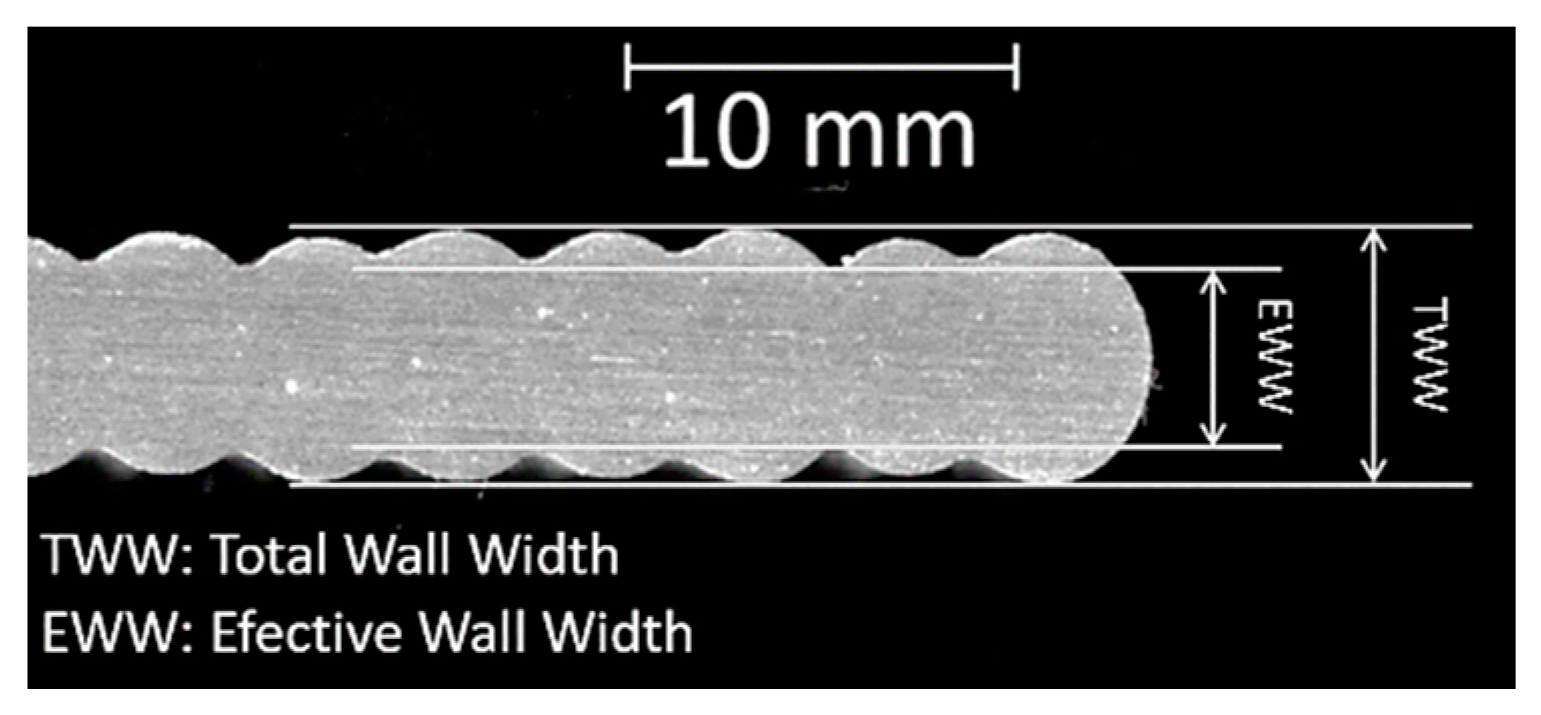
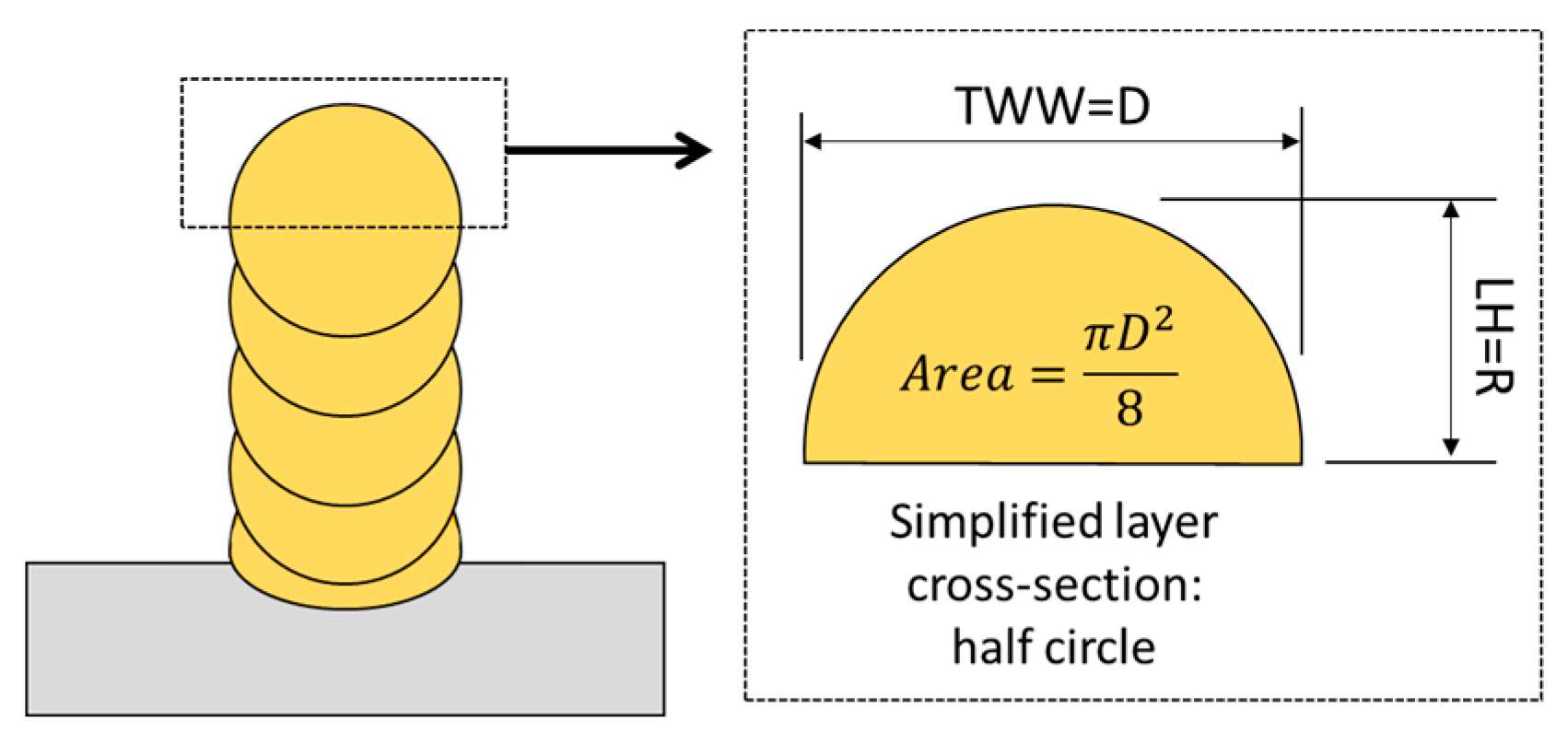
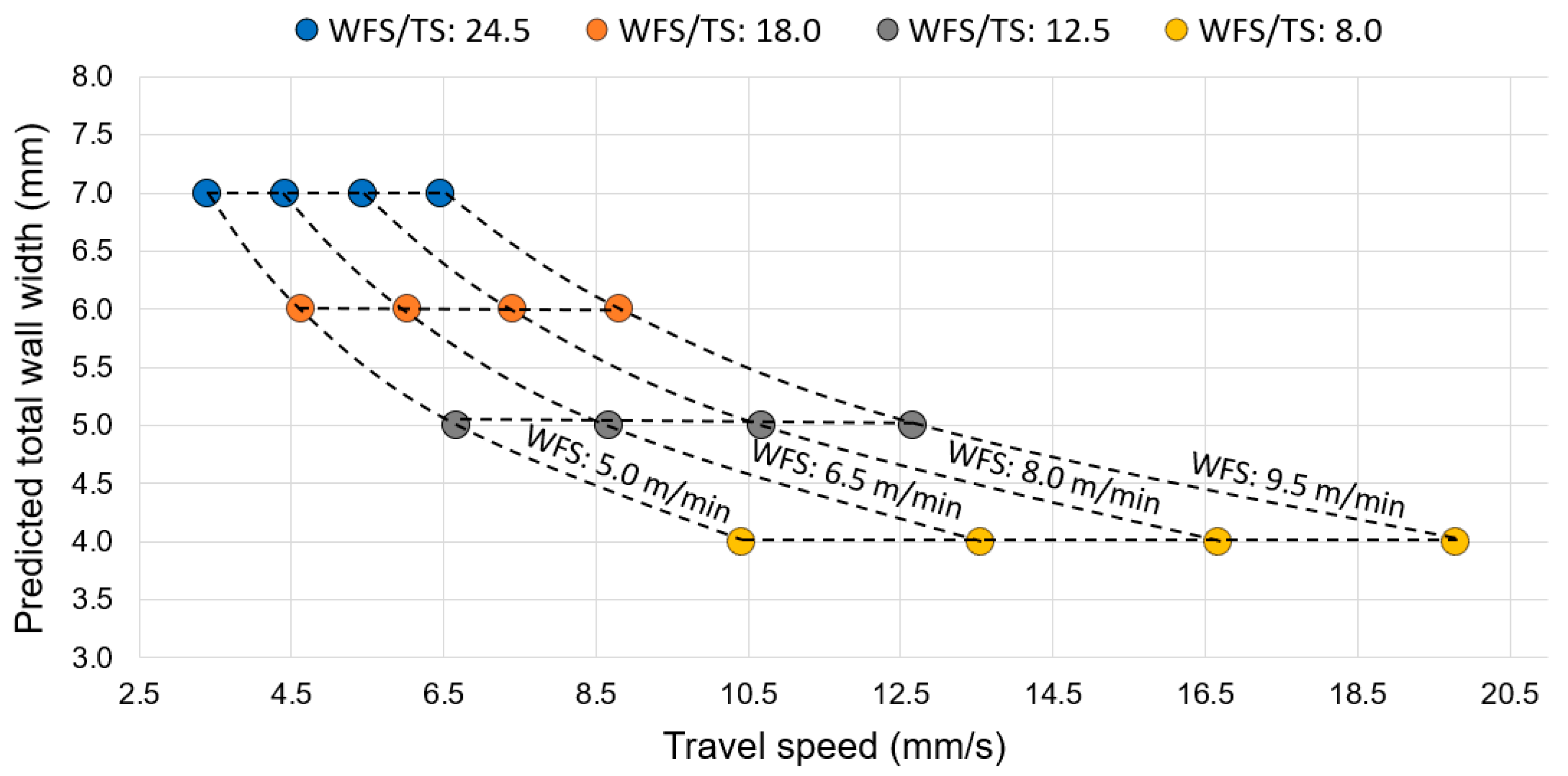
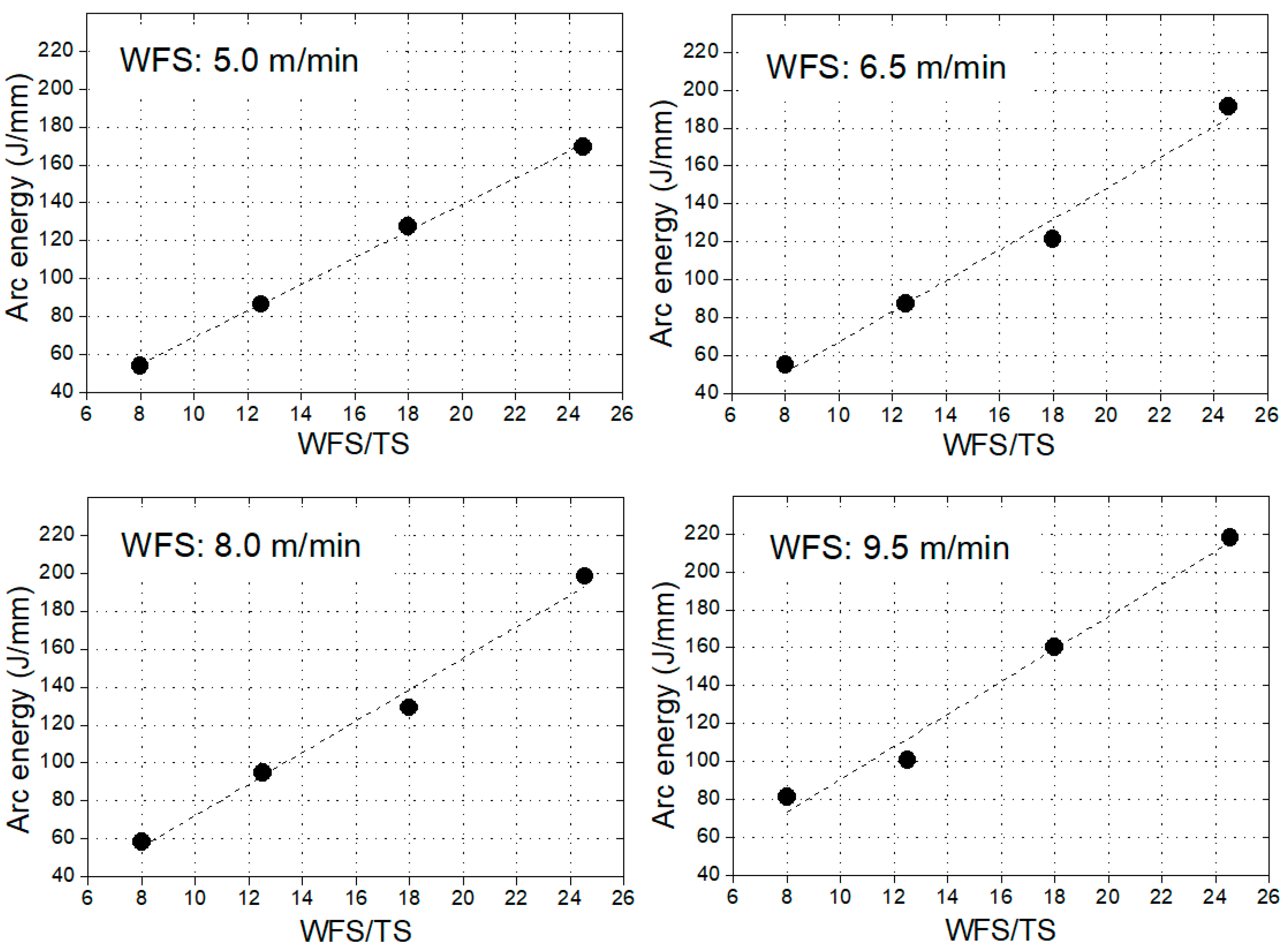
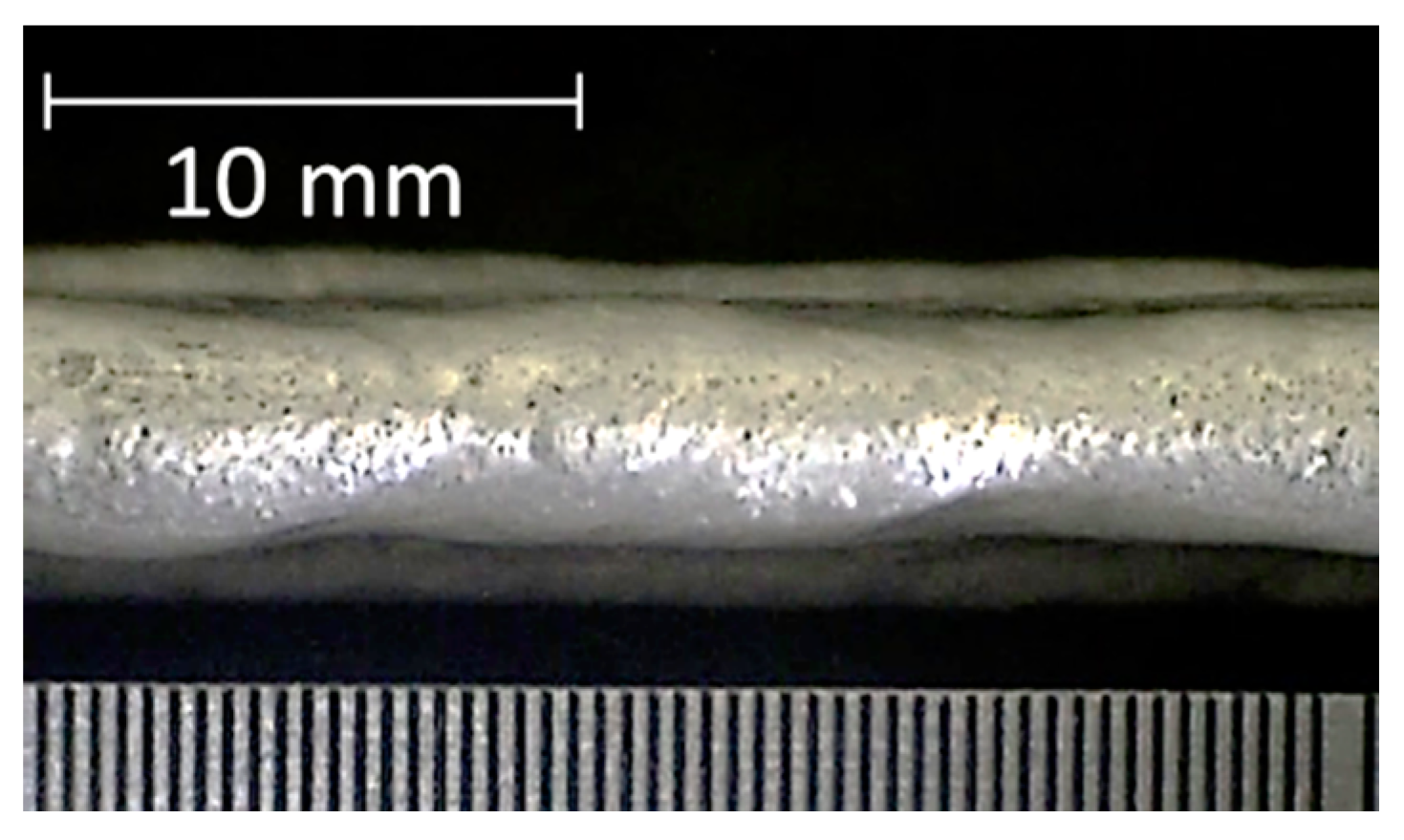
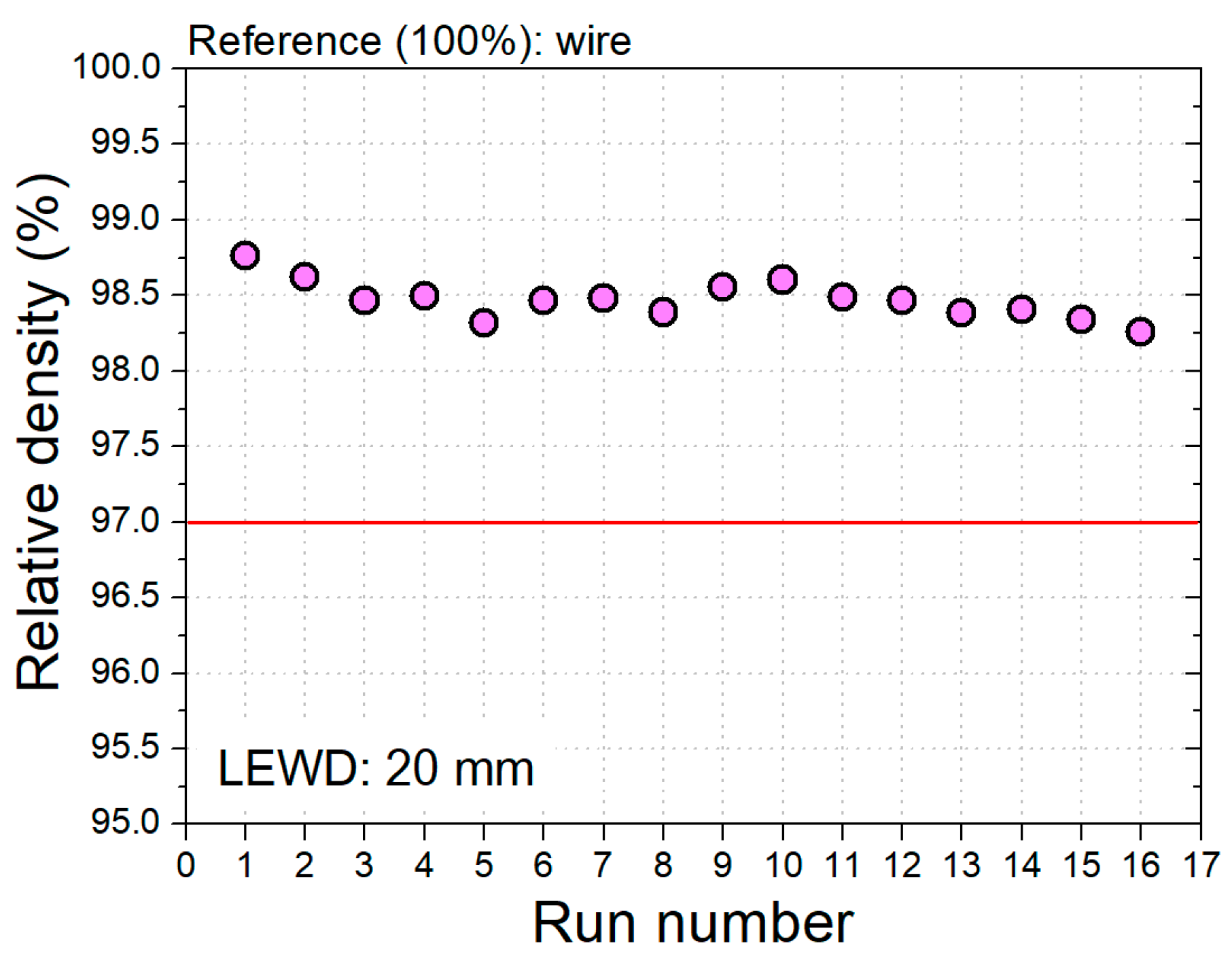

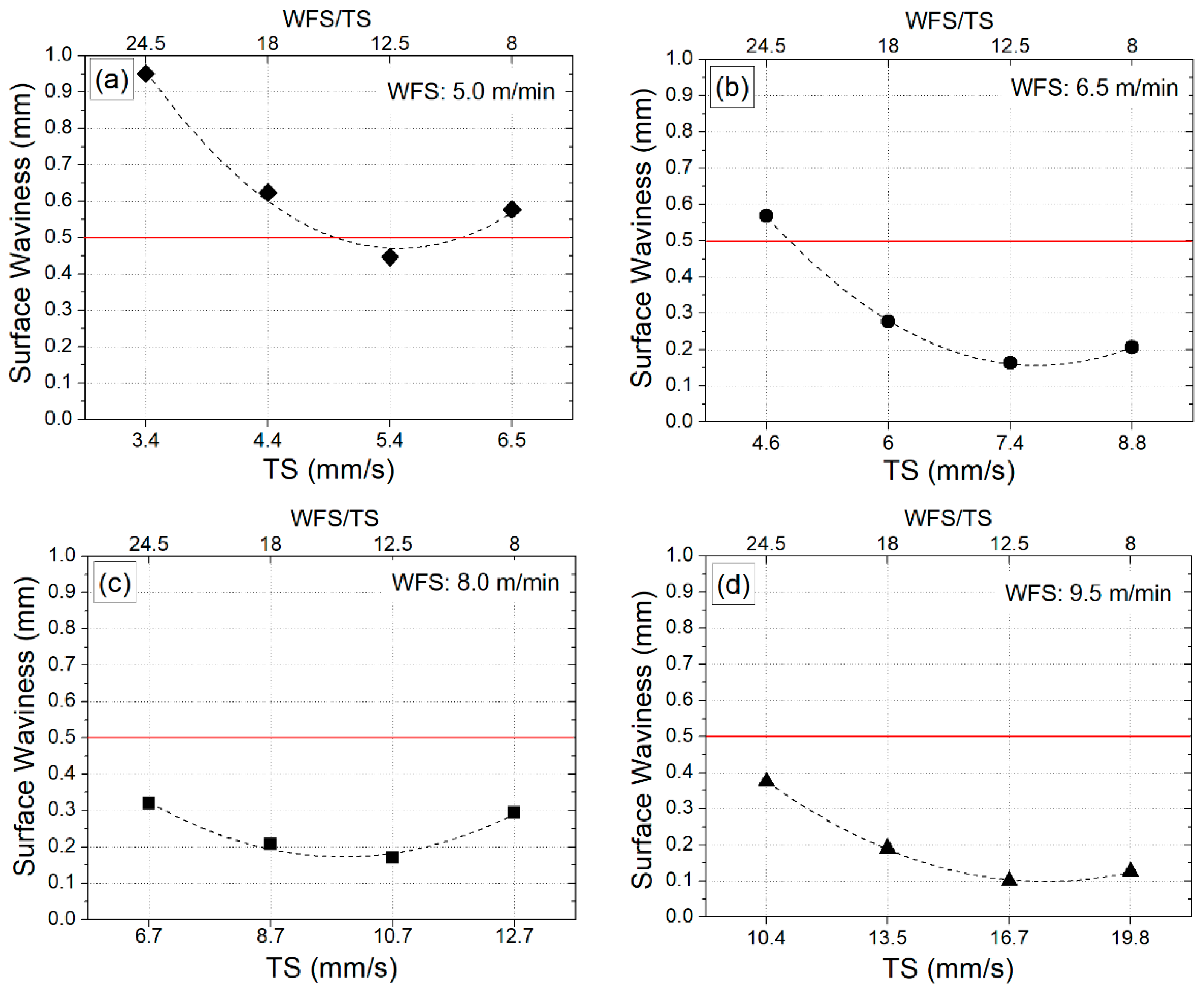
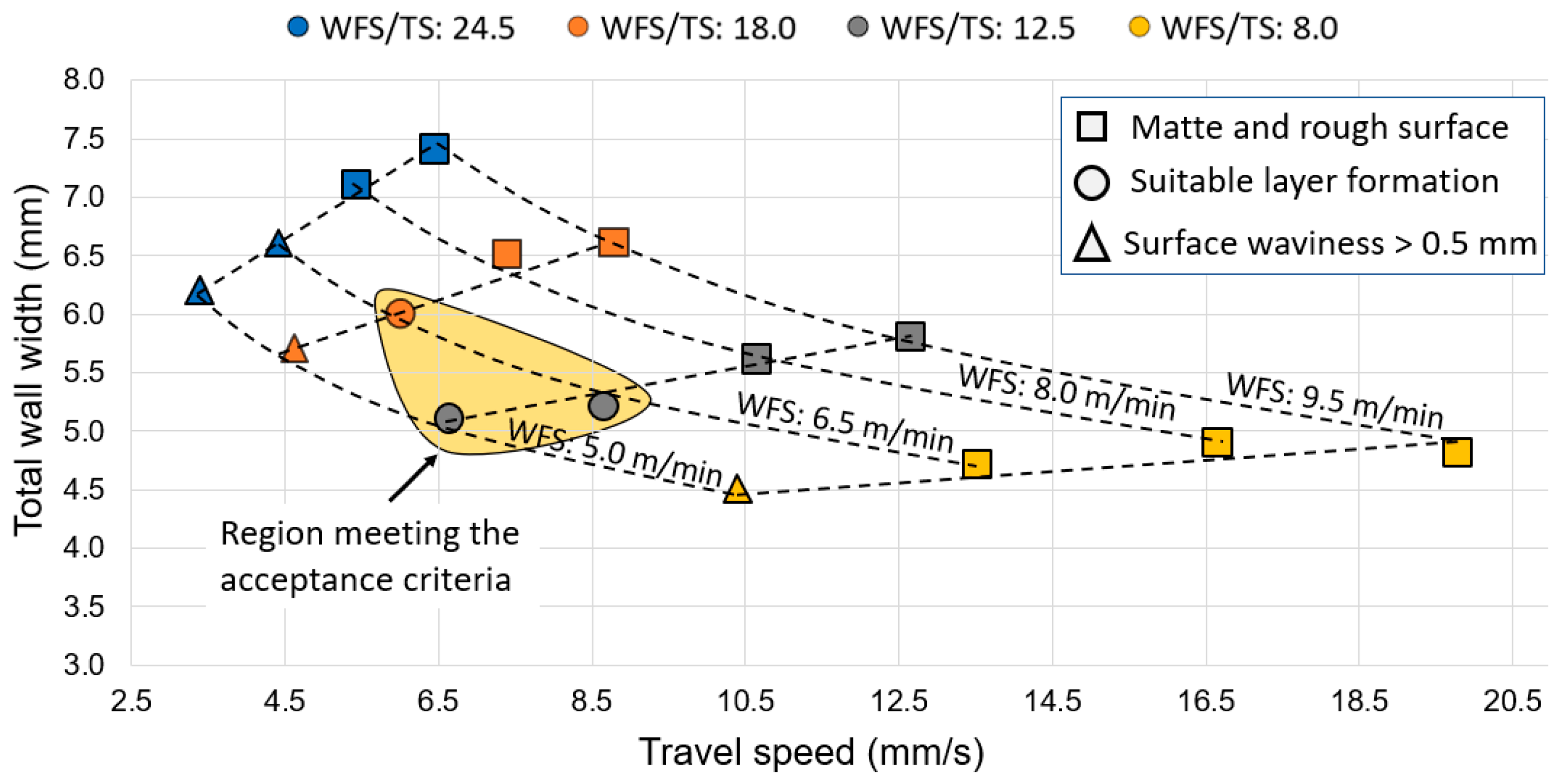
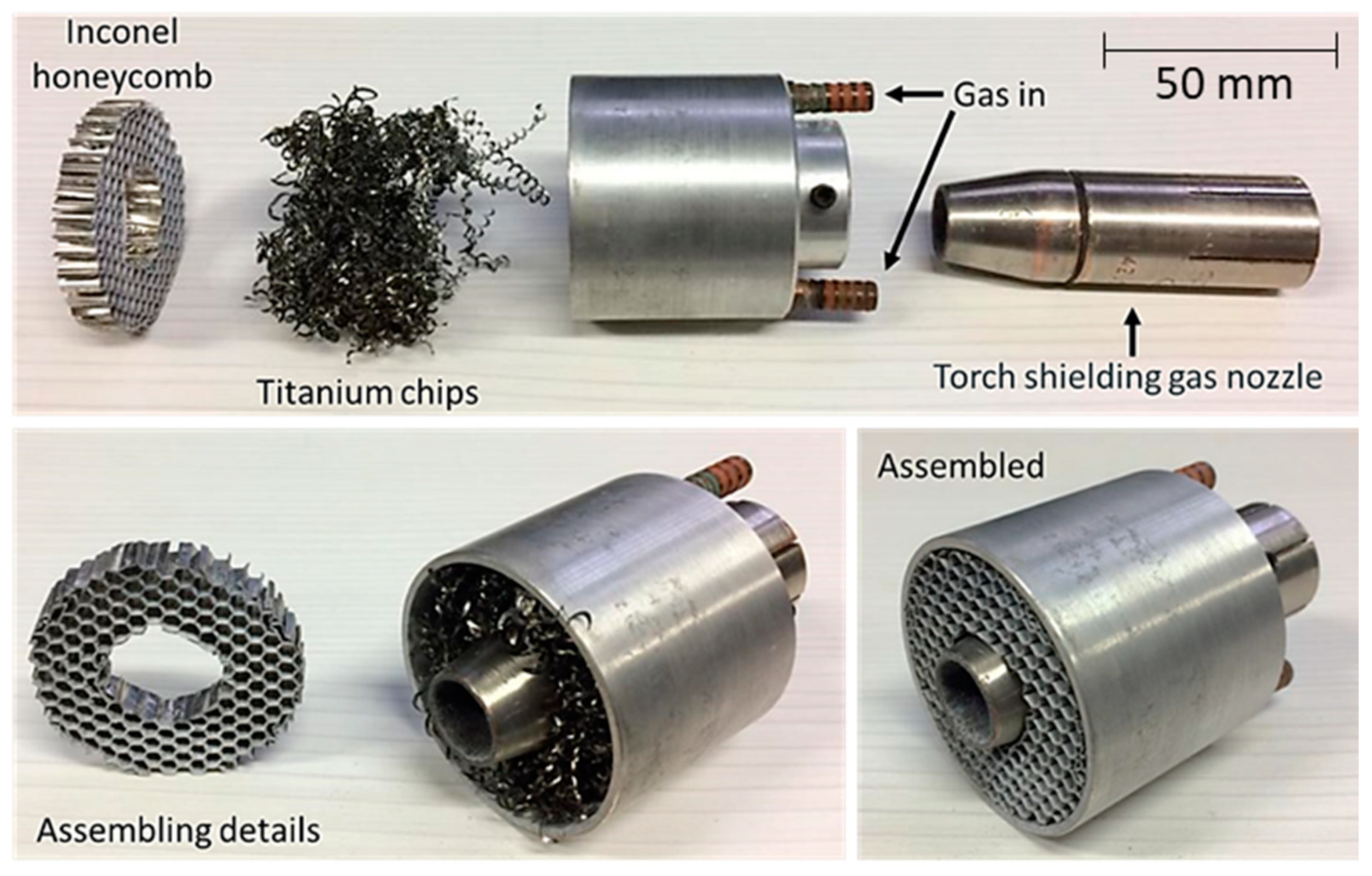
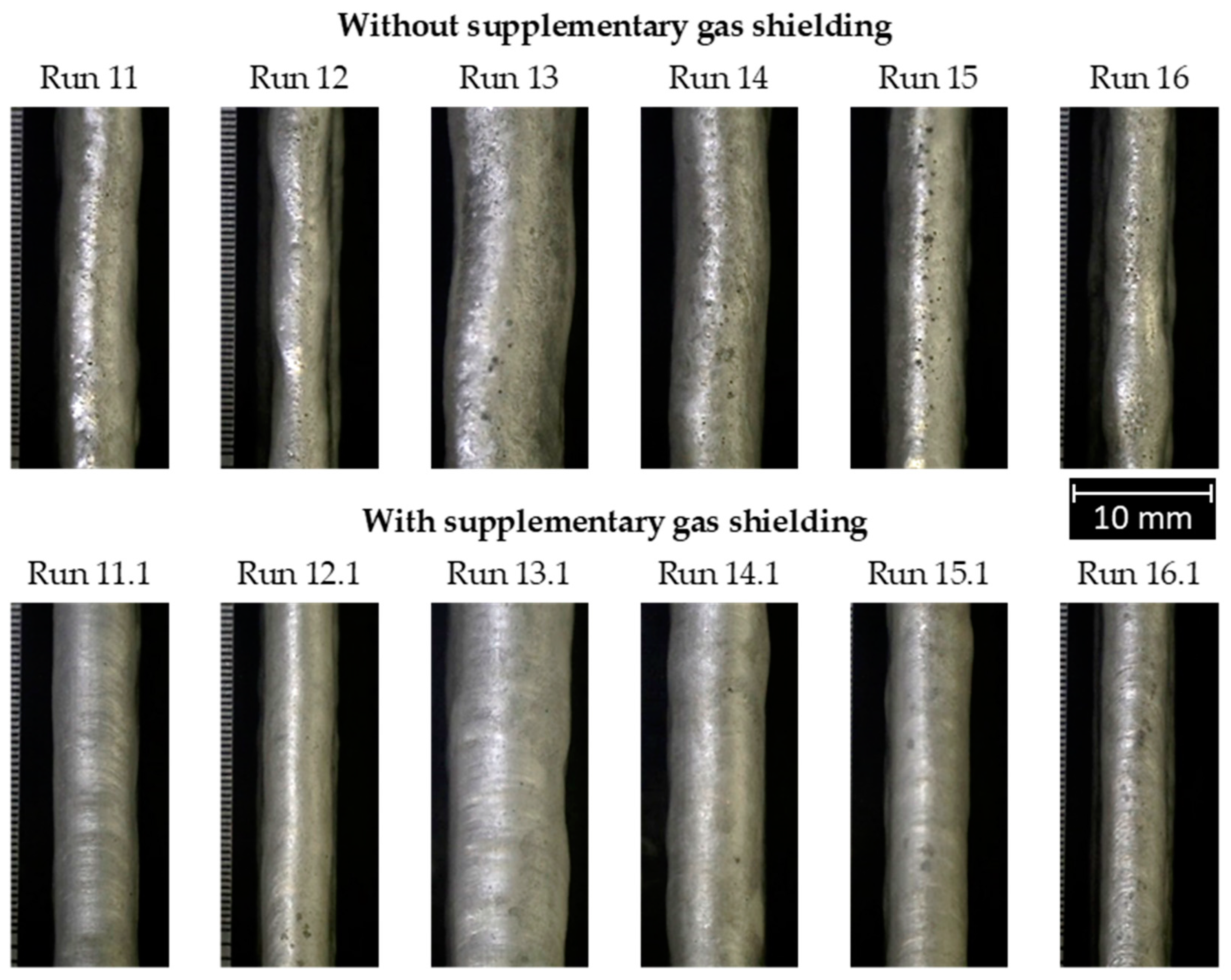
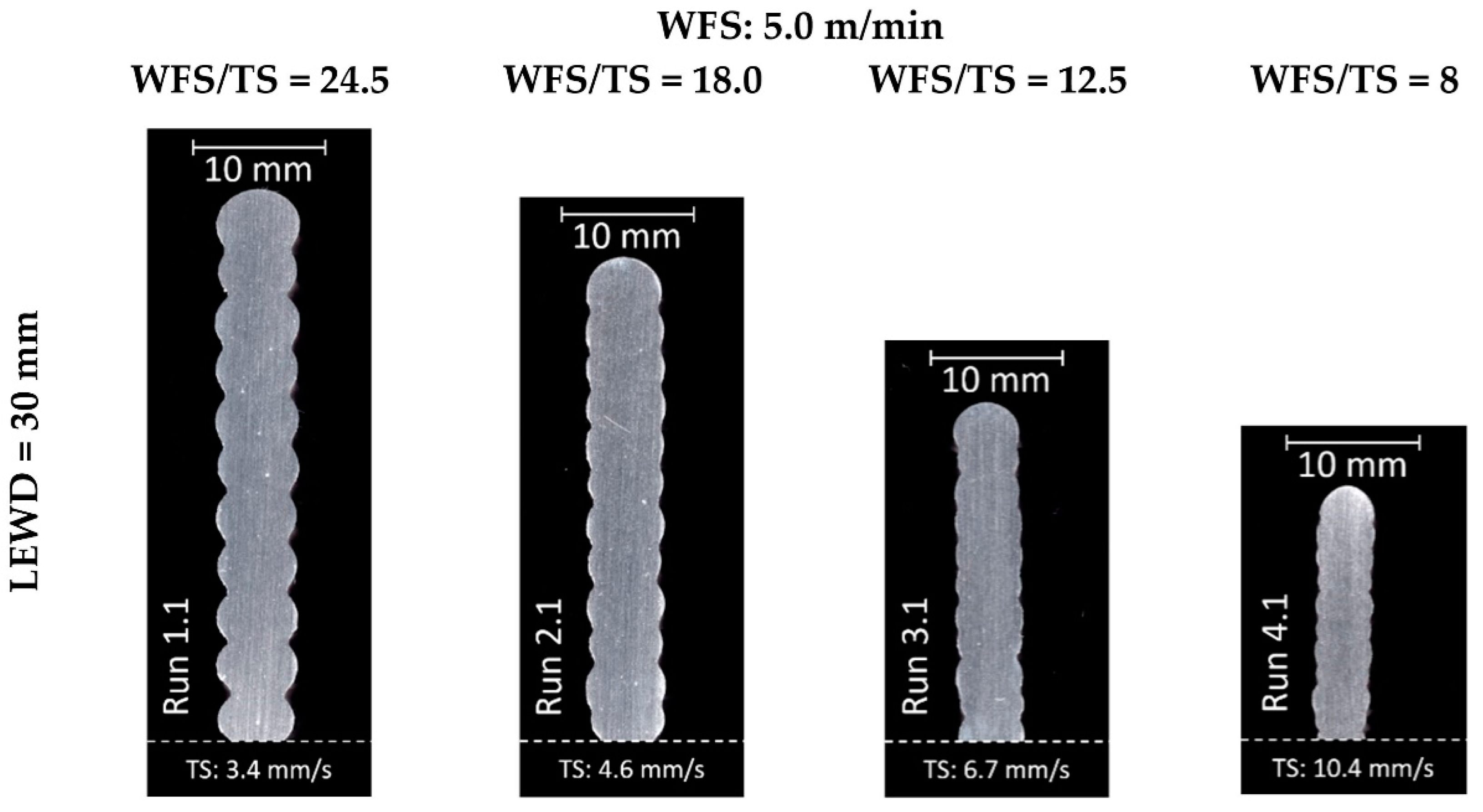
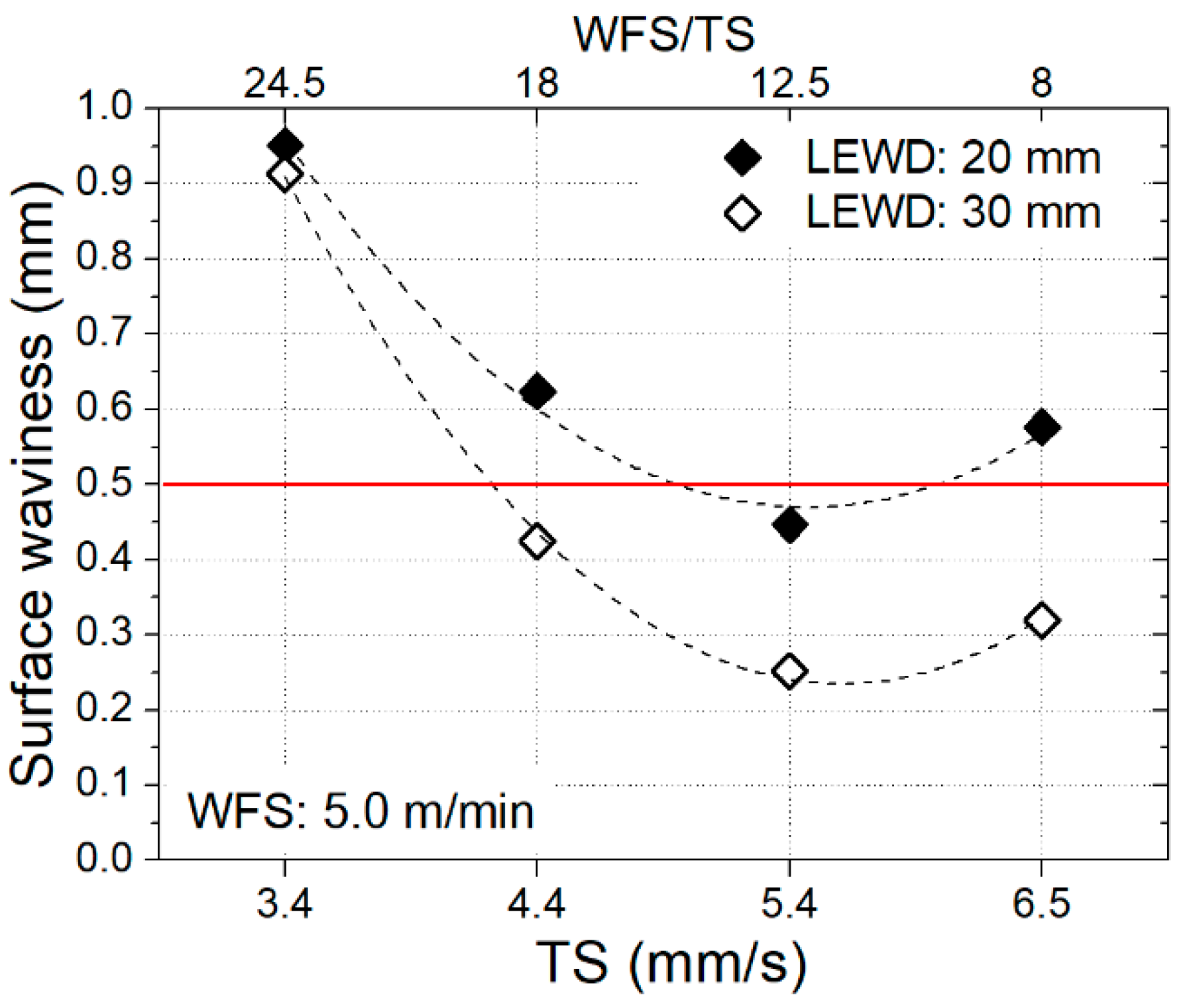
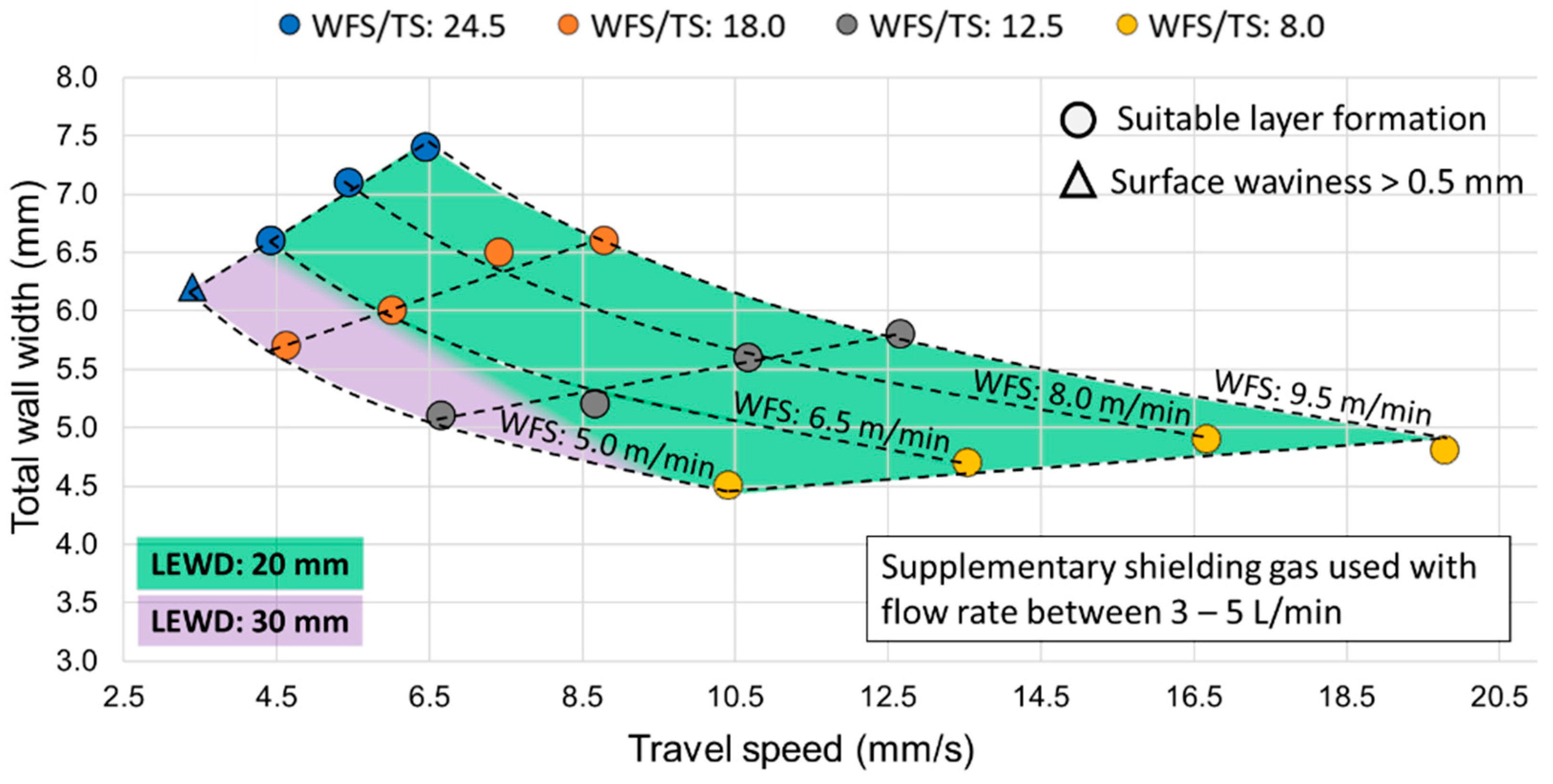
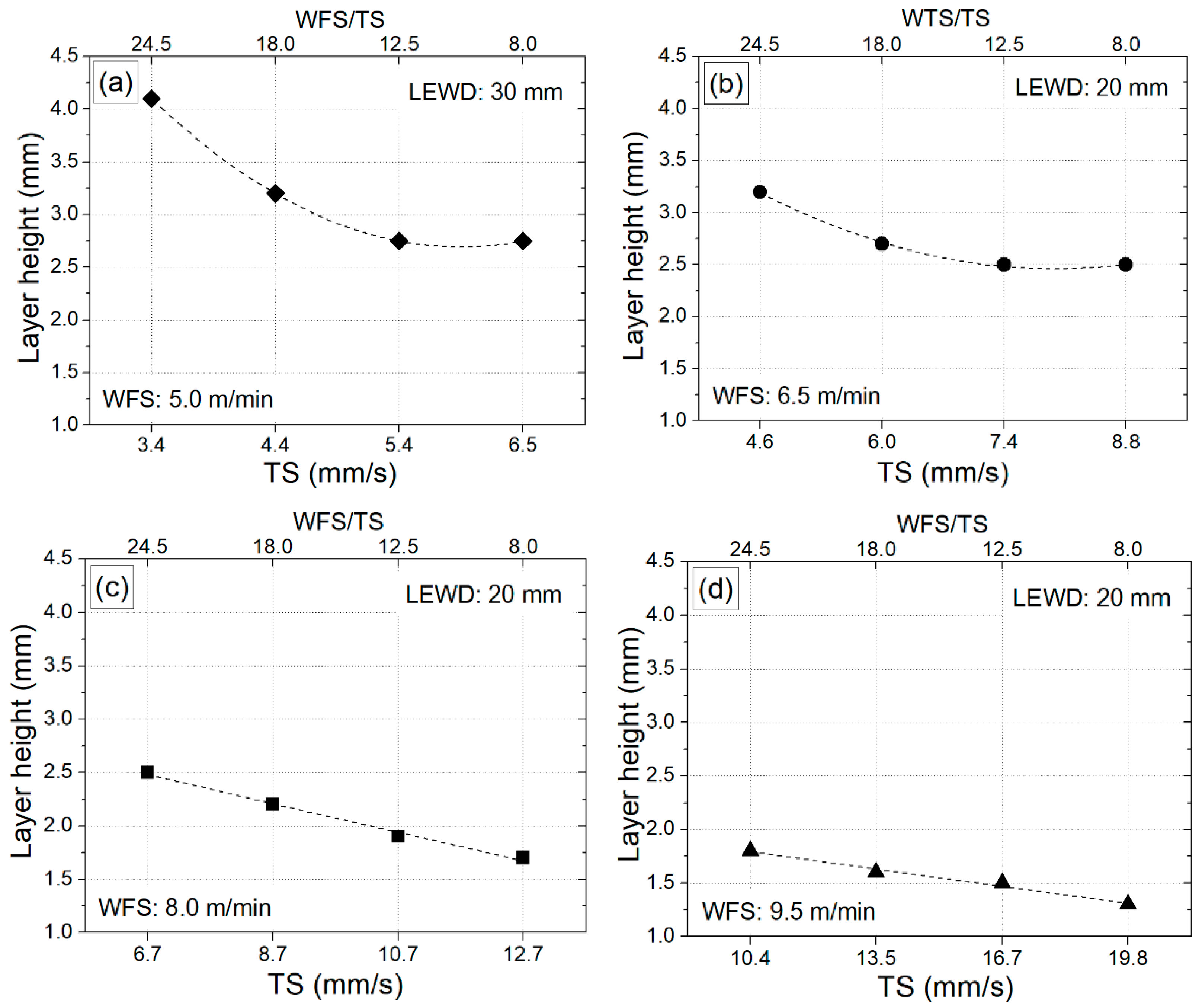
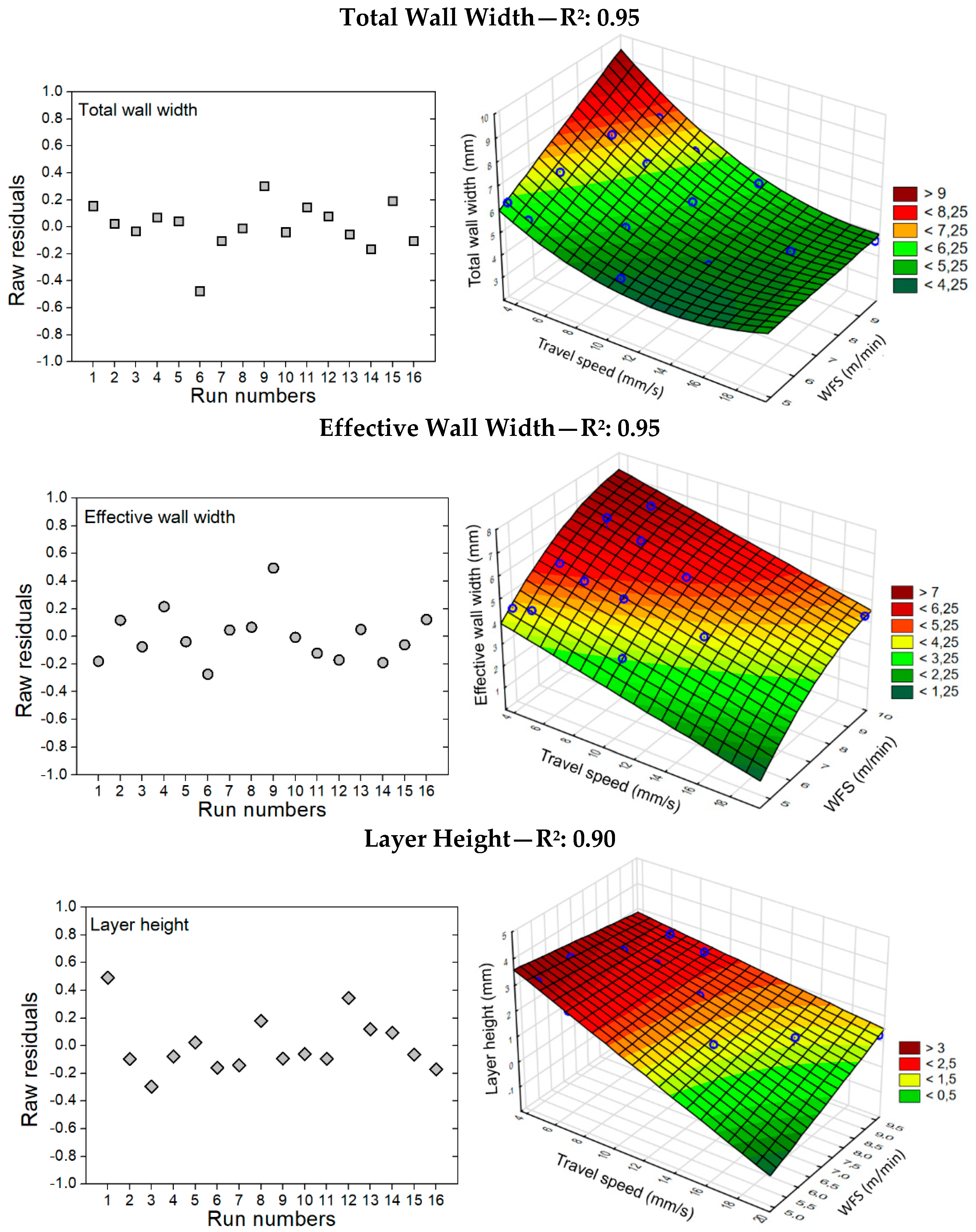


| Reference | Process Material | Contribution |
|---|---|---|
| Martina et al. [6] | Plasma Ti6Al4V | Designed an operational map from experimental trials by using statistical tools for WAAM. |
| Ríos et al. [7] | Plasma Ti6Al4V | Proposed an analytical process model for predicting layer height and wall width, which includes inter-pass temperature and material properties. |
| Ali et al. [8] | GMA Hot work tool steel | Assessed the effect of process parameters on bead geometry and highlighted the difference between adjusted and measured wire feed speed for the CMT process. |
| Marinelli et al. [9] | GTA Unalloyed tungsten | Expanded the work envelope in terms of travel speed by changing the shielding gas composition. |
| Michel et al. [10] | Plasma Ti6Al4V | Developed a path planning solution by incorporating the modularity of design into the path planning task. |
| Henckell et al. [11] | GMA Low-alloyed steel | Expanded the work envelope by a systematic variation of the CTWD value. |
| Scotti et al. [12] | GMA Al5Mg | Improved the process robustness via an active cooling technique and by systematically varying the electrode polarity ratio. |
| Ding et al. [13] | GMA Al5Si | Developed a process planning to achieve better shape accuracy and material efficiency in structures with sharp corners. |
| Arc deposition equipment | Fronius CMT—TransPuls Synergic 500 |
| Deposition material | AWS ER 5356-Ø 1.0 mm Wire |
| Substrate | Al5052 (220 × 38.1 × 6.4 mm) plate |
| CTWD 1 | 12 mm |
| Shielding gas | Commercial argon (15 L/min) |
| Cooling liquid | Tap water at around 20 °C |
| Work tank volume | 50 L |
| Preform geometry | Single wall with 12 layers and length of 200 mm |
| Building strategy | Single-pass multi-layers bidirectional deposition |
| Dwell time | 10 s/layer |
| Thermal management | Near-immersion Active Cooling—NIAC |
| Run | Predicted TWW (mm) | Predicted LH (mm) | WFS (m/min) | TS (mm/min) | WFS/TS (-) 1 |
|---|---|---|---|---|---|
| 1 | 7.0 | 3.5 | 5.0 | 3.4 | 24.5 |
| 2 | 6.0 | 3.0 | 5.0 | 4.6 | 18.0 |
| 3 | 5.0 | 2.5 | 5.0 | 6.7 | 12.5 |
| 4 | 4.0 | 2.0 | 5.0 | 10.4 | 8.0 |
| 5 | 7.0 | 3.5 | 6.5 | 4.4 | 24.5 |
| 6 | 6.0 | 3.0 | 6.5 | 6.0 | 18.0 |
| 7 | 5.0 | 2.5 | 6.5 | 8.7 | 12.5 |
| 8 | 4.0 | 2.0 | 6.5 | 13.6 | 8.0 |
| 9 | 7.0 | 3.5 | 8.0 | 5.5 | 24.5 |
| 10 | 6.0 | 3.0 | 8.0 | 7.4 | 18.0 |
| 11 | 5.0 | 2.5 | 8.0 | 10.7 | 12.5 |
| 12 | 4.0 | 2.0 | 8.0 | 16.7 | 8.0 |
| 13 | 7.0 | 3.5 | 9.5 | 6.5 | 24.5 |
| 14 | 6.0 | 3.0 | 9.5 | 8.8 | 18.0 |
| 15 | 5.0 | 2.5 | 9.5 | 12.7 | 12.5 |
| 16 | 4.0 | 2.0 | 9.5 | 19.8 | 8.0 |
| Features | Method of Inspection | Acceptance Criteria |
|---|---|---|
| Surface aspect | Visual | The surface of the layer shall be smooth, shiny, and sufficiently free from coarse undulations, grooves, overlaps, abrupt ridges, and valleys. |
| Surface waviness | Cross-section analyses | The surface waviness shall be lower than 0.5 mm [21]. |
| Relative density | Archimedes’ method | The preform relative density shall be higher than 97% [22]. |
| T (mm) | 4.0 | 4.5 | 5.0 | 5.5 | 6.0 | 6.5 |
| WFS (m/min) | 6.9 | 7.7 | 8.7 | 8.5 | 9.4 | 9.4 |
| TS (mm/min) | 14.1 | 14.8 | 15.2 | 11.7 | 10.8 | 9.3 |
| LH (mm) | 1.4 | 1.5 | 1.7 | 2 | 2.2 | 2.3 |
| LEWD (mm) | 27 | 22 | 20 | 20 | 20 | 20 |
Publisher’s Note: MDPI stays neutral with regard to jurisdictional claims in published maps and institutional affiliations. |
© 2021 by the authors. Licensee MDPI, Basel, Switzerland. This article is an open access article distributed under the terms and conditions of the Creative Commons Attribution (CC BY) license (https://creativecommons.org/licenses/by/4.0/).
Share and Cite
da Silva, L.J.; Teixeira, F.R.; Araújo, D.B.; Reis, R.P.; Scotti, A. Work Envelope Expansion and Parametric Optimization in WAAM with Relative Density and Surface Aspect as Quality Constraints: The Case of Al5Mg Thin Walls with Active Cooling. J. Manuf. Mater. Process. 2021, 5, 40. https://doi.org/10.3390/jmmp5020040
da Silva LJ, Teixeira FR, Araújo DB, Reis RP, Scotti A. Work Envelope Expansion and Parametric Optimization in WAAM with Relative Density and Surface Aspect as Quality Constraints: The Case of Al5Mg Thin Walls with Active Cooling. Journal of Manufacturing and Materials Processing. 2021; 5(2):40. https://doi.org/10.3390/jmmp5020040
Chicago/Turabian Styleda Silva, Leandro João, Felipe Ribeiro Teixeira, Douglas Bezerra Araújo, Ruham Pablo Reis, and Américo Scotti. 2021. "Work Envelope Expansion and Parametric Optimization in WAAM with Relative Density and Surface Aspect as Quality Constraints: The Case of Al5Mg Thin Walls with Active Cooling" Journal of Manufacturing and Materials Processing 5, no. 2: 40. https://doi.org/10.3390/jmmp5020040
APA Styleda Silva, L. J., Teixeira, F. R., Araújo, D. B., Reis, R. P., & Scotti, A. (2021). Work Envelope Expansion and Parametric Optimization in WAAM with Relative Density and Surface Aspect as Quality Constraints: The Case of Al5Mg Thin Walls with Active Cooling. Journal of Manufacturing and Materials Processing, 5(2), 40. https://doi.org/10.3390/jmmp5020040






